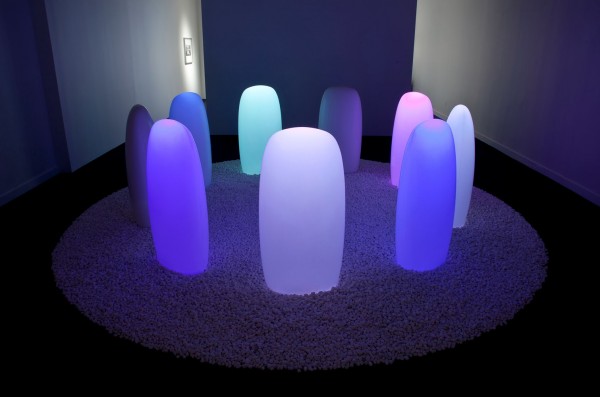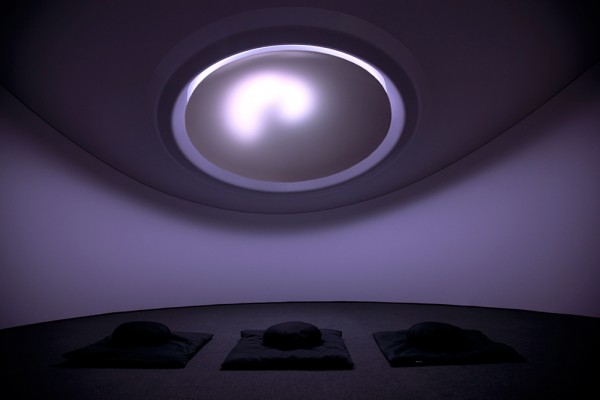
Mariko Mori, “Transcircle 1.1,” stone, Corian, LED, real-time control system, 2004 (courtesy of the Mori Art Museum, Tokyo / photo by Richard Goodbody)
Japan Society
333 East 47th St. at First Ave.
Tuesday – Sunday through January 12, $12 (free Friday from 6:00 to 9:00)
212-715-1258
www.japansociety.org
For her first museum show in more than a decade, Tokyo-born artist Mariko Mori explores the interconnectedness between humanity and the cosmos, the body and the universe, and the endless cycle of birth, death, and rebirth. Continuing through January 12 at Japan Society, “Rebirth” comprises sculpture, video, photography, and installation that celebrates peace and love while delving into a past, present, and future that comes together through primal consciousness. “Why are souls born in this world, and why do we depart to another world? Why have we chosen to leave that world to be born in this world and exist in the here and now?” Mori asked in a 2007 interview with Lida Takayo that the author incorporates into the exhibition catalog essay “Mariko Mori’s ‘Rebirth’: Ancient, Futuristic Visions.” “There can be only one answer. We are here so that we can experience love. I was born here so that my love can bring peace to the world,” Mori concludes. The artist, who lives and works in Tokyo, London, and New York, takes visitors on a journey from the Middle Jōmon period of several thousand centuries BCE to the birth of a star, beginning with the glowing Lucite “Ring,” which hangs over the lobby pond, and “Birds I,” nearly hidden in the bamboo garden above. The pairing of “Primal Memory” with “Mask,” followed by “Flatstone” and “Transcircle 1.1,” meld such ancient traditions as the stone circle with modern technology; for example, the Stonehenge-like “Transcircle 1.1” consists of nine tall monoliths arranged in a circle, glowing in changing LED color schemes based on the orbit of the eight planets and Pluto around the sun. Meanwhile, the ceramic rocks in “Flatstone” are centered by an acrylic version of the Middle Jōmon vase on view nearby.

Mariko Mori, “White Hole,” acrylic and LED lights, 2008-10 (courtesy SCAI THE BATHHOUSE, Tokyo, and Sean Kelly, New York / photo by Richard Goodbody)
In the almost blindingly white Bamboo Room, consciousness is further raised in “Miracle,” comprising eight brightly colored Cibachrome prints on the back wall and a round platform over which a small crystal ball dangles on a chain above the smooth epoxy orb “Tama I” and salt. Walking slowly around the platform offers visitors a changing reality. The exhibition, which also includes the “Journey to Seven Light Bay, Primal Rhythm” video of the first of Mori’s six planned outdoor site-specific environmental sculptural projects, the drawing series “Higher Being” and “White Hole,” and the “Ālaya” digital video (as well as bonus black-and-white archaeological photographs on the lower level), concludes with the consciousness-expanding immersive multimedia installation “White Hole.” In a dark room at the end of a short, winding corridor, a convex circle awaits, looking like a large futuristic eye centered on a low, angled ceiling. Soon a light projection emerges, growing and spiraling as it echoes a star being absorbed into a black hole and being freed from gravity through a white hole. “If the dramas of death and rebirth, as well as new birth, unfold across many parallel dimensions, there exists an eternal time and space that has no beginning and no end,” Mori has said about the piece. “I hope this work serves as a simulacrum of death and rebirth, prompting us to rethink the multidimensional universe that defies our imagination.” To get the full experience, visitors should first lie down on the provided mat, staring into the middle of the hole, but then get up and approach the light, following its dizzying journey. In fact, much of “Rebirth” is rewarded by spending time with the objects, meditating on them while considering the interdependence of humanity and the universe.